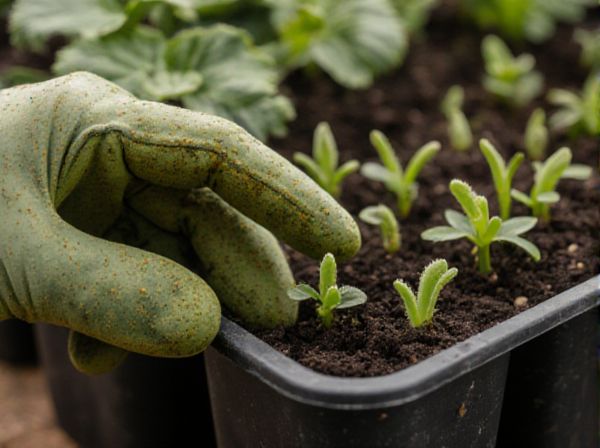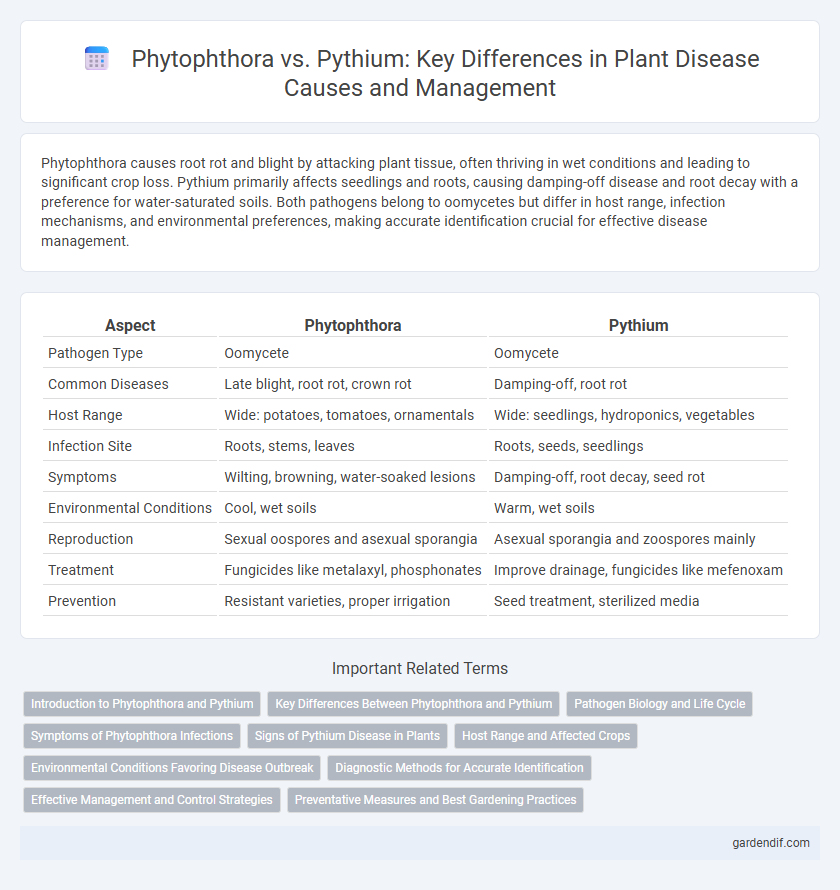
Phytophthora vs Pythium Illustration
Phytophthora causes root rot and blight by attacking plant tissue, often thriving in wet conditions and leading to significant crop loss. Pythium primarily affects seedlings and roots, causing damping-off disease and root decay with a preference for water-saturated soils. Both pathogens belong to oomycetes but differ in host range, infection mechanisms, and environmental preferences, making accurate identification crucial for effective disease management.
Table of Comparison
| Aspect | Phytophthora | Pythium |
|---|---|---|
| Pathogen Type | Oomycete | Oomycete |
| Common Diseases | Late blight, root rot, crown rot | Damping-off, root rot |
| Host Range | Wide: potatoes, tomatoes, ornamentals | Wide: seedlings, hydroponics, vegetables |
| Infection Site | Roots, stems, leaves | Roots, seeds, seedlings |
| Symptoms | Wilting, browning, water-soaked lesions | Damping-off, root decay, seed rot |
| Environmental Conditions | Cool, wet soils | Warm, wet soils |
| Reproduction | Sexual oospores and asexual sporangia | Asexual sporangia and zoospores mainly |
| Treatment | Fungicides like metalaxyl, phosphonates | Improve drainage, fungicides like mefenoxam |
| Prevention | Resistant varieties, proper irrigation | Seed treatment, sterilized media |
Introduction to Phytophthora and Pythium
Phytophthora and Pythium are soilborne pathogens belonging to the Oomycetes group, causing significant root and crown rot diseases in plants. Phytophthora species are known for aggressive infections leading to wilting and decay, particularly in crops like potatoes, tomatoes, and avocados. Pythium species primarily affect seedling emergence and root systems, often resulting in damping-off disease in a wide range of horticultural and agricultural plants.
Key Differences Between Phytophthora and Pythium
Phytophthora causes root rot and blight mainly in woody plants, while Pythium primarily leads to damping-off and root rot in seedlings and grasses. Phytophthora species produce larger, sporangia that release zoospores under wet conditions, whereas Pythium species form smaller, filamentous sporangia and exhibit faster colonization in water-saturated soils. Unlike Pythium, Phytophthora has a wider host range and typically causes more aggressive infections with distinct lesions and wilting symptoms.
Pathogen Biology and Life Cycle
Phytophthora species are oomycete pathogens characterized by their heterothallic or homothallic sexual reproduction, producing oospores that enable long-term survival and dispersal through zoospores in water-saturated soils. Pythium species, also oomycetes as well, have faster life cycles with predominantly asexual reproduction via sporangia and zoospores, facilitating rapid colonization in moist environments. Both genera produce motile biflagellate zoospores critical for infection, but Phytophthora oospores provide greater resilience in harsh conditions compared to Pythium survival structures.
Symptoms of Phytophthora Infections
Phytophthora infections cause root rot, stem lesions, and wilting in affected plants, often leading to rapid decline and death. Symptoms include water-soaked lesions on roots and stems that darken and become necrotic, disrupting vascular tissue and impairing water transport. Leaf yellowing, chlorosis, and defoliation commonly occur as the infection progresses, distinguishing Phytophthora from Pythium, which primarily causes damping-off symptoms in seedlings.
Signs of Pythium Disease in Plants
Pythium disease in plants typically manifests as water-soaked lesions on roots, leading to root rot and damping-off in seedlings. Infected plants show stunted growth, yellowing leaves, and wilting despite adequate moisture. Soft, brown, and decayed root tissues are key diagnostic signs distinguishing Pythium infections from similar root diseases caused by Phytophthora.
Host Range and Affected Crops
Phytophthora species primarily affect a wide range of woody plants, including potatoes, tomatoes, and grapes, causing root rot and blight diseases, while Pythium targets various vegetable crops like carrots, cucumbers, and lettuce, leading to damping-off and root rot. Phytophthora exhibits a preference for hosts in both agricultural and natural ecosystems, severely impacting crops such as potatoes (Phytophthora infestans) and ornamentals. Pythium's broad host range includes numerous greenhouse and field crops, where it thrives in poorly drained soils, causing significant losses in seedling establishment and crop yield.
Environmental Conditions Favoring Disease Outbreak
Phytophthora thrives in saturated soils with poor drainage and temperatures between 65degF to 75degF, creating ideal conditions for root rot and stem blight in various crops. Pythium favors cooler, waterlogged soils ranging from 55degF to 70degF, promoting damping-off and seed rot in seedlings and young plants. Both pathogens exploit excessive moisture, but Phytophthora is more aggressive in warmer, stagnant environments while Pythium proliferates under cooler, persistently wet conditions.
Diagnostic Methods for Accurate Identification
Accurate identification of Phytophthora and Pythium species relies heavily on molecular diagnostic methods such as PCR amplification targeting specific gene regions like ITS and COX genes. Microscopic examination combined with culture-based techniques on selective media enables differentiation based on sporangia morphology and growth patterns. Advanced tools like real-time PCR and DNA sequencing provide precise, rapid detection essential for effective disease management strategies in agriculture and horticulture.
Effective Management and Control Strategies
Effective management of Phytophthora involves the use of fungicides containing metalaxyl or phosphonates, alongside well-drained soil to prevent waterlogging, which favors the pathogen. Pythium is best controlled through soil sterilization, crop rotation, and application of fungicides like mefenoxam, targeting its rapid growth in saturated soils. Both pathogens require integrated approaches combining cultural practices and chemical treatments to reduce disease incidence and improve plant health.
Preventative Measures and Best Gardening Practices
Phytophthora and Pythium are waterborne pathogens that thrive in overly saturated soils, making proper drainage and avoiding waterlogged conditions essential for prevention. Employing well-draining soil mixes, practicing crop rotation, and sterilizing gardening tools reduce the risk of infection by limiting pathogen survival and spread. Using resistant plant varieties and applying fungicide drenches specifically targeting oomycetes can further enhance disease management in susceptible environments.
Phytophthora vs Pythium Infographic

 gardendif.com
gardendif.com